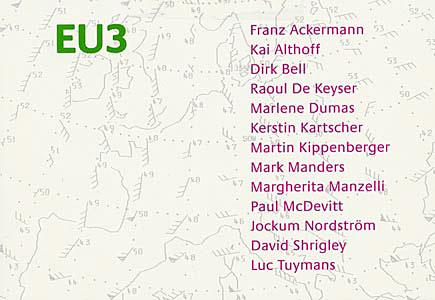EU3
dal 9/9/2003 al 11/10/2003
Segnalato da
Franz Ackermann
Kai Althoff
Dirk Bell
Raoul De Keyser
Marlene Dumas
Kerstin Kartscher
Martin Kippenberger
Mark Manders
Margherita Manzelli
Paul McDevitt
Jockum Nordstrom
David Shrigley
Luc Tuymans
9/9/2003
EU3
Stephen Friedman Gallery, London
An exhibition of current trends in European drawing. Included in the show are new and recent works by Franz Ackermann, Kai Althoff, Dirk Bell, Raoul De Keyser, Marlene Dumas, Kerstin Kartscher, Martin Kippenberger, Mark Manders, Margherita Manzelli, Paul McDevitt, Jockum Nordström, David Shrigley and Luc Tuymans.

Stephen Friedman Gallery is pleased to present EU3, an exhibition of current trends in European drawing. Included in the show are new and recent works by Franz Ackermann, Kai Althoff, Dirk Bell, Raoul De Keyser, Marlene Dumas, Kerstin Kartscher, Martin Kippenberger, Mark Manders, Margherita Manzelli, Paul McDevitt, Jockum Nordström, David Shrigley and Luc Tuymans.
Drawing is an essential component of these artists' works, whether as their primary practice or to complement other ways of making art. This exhibition will include a fascinating variety of approaches to the medium.
Over the past ten years, Franz Ackermann has developed a multifaceted body of work which explores his experience of travelling, globalisation and tourism. Ackermann's vibrant, intensely coloured and dynamic gouaches, which he refers to as "Mental Maps", combine the extended reality of a place with the artist's subjective feelings about it.
Kai Althoff's drawings alternate between abstraction and figuration. Narrative elements in the work range from left-wing youth culture, Gebrüder Grimm, Nazi Germany to 19th-Century Romanticism. The drawings have an ominous yet tender sensibility and a sentimentality for the dark side of the human condition.
Dirk Bell's drawings portray ephemeral figures often set within dark, gothic and romantic surroundings. The works are quickly rendered, using watercolour and pencil to grasp a train of fleeting associations. There is something intoxicating, beyond the reach of the known world, in Bell's works on paper.
Practising since the 1960s, Raoul De Keyser manages to merge figuration and abstraction, gesture and geometry, background and surface. In his drawings, planes and forms are freely layered on top of each other and autonomous shapes intrude, overlap and wipe each other out.
Marlene Dumas is known for making expressive and decisive drawings of human figures and faces. Dumas layers visual information fraught with stark oppositions and subtle meanings. Her drawings portray a delicately negotiated sexuality and violence.
Kerstin Kartscher's drawings combine architectural features, landscape and portraiture. Using a plain colour scheme and a graphic style, Kartscher uses romantic motifs into which she weaves symbols of contemporary everyday culture. She takes us on a journey to fantastic places where familiar things have been rearranged in the most improbable ways.
While travelling extensively, Martin Kippenberger made hundreds of drawings on hotel stationery. No subject matter, high or low, remains untouched in the universe of these ironic and poignant drawings. Their versatile style ranges from simple doodles to highly finished compositions and sketches which relate to his paintings, sculptures and installations.
According to Mark Manders' way of looking at the world, everything is potentially in motion. Consequently he describes his work as a constantly evolving "self-portrait as a building". In Manders' practice, drawings and sculptural elements overlap and when his mental pictures are transferred to paper, his works take on a poetic quality. His entire oeuvre is based on the disappearance of the distinction between thoughts and objects.
Margherita Manzelli portrays the loneliness of subjects very close to the margins of normality. Her figures are obsessively rendered and have an erotic and unconventional beauty. The viewer is simultaneously drawn to and repulsed by Manzelli's self-possessed young women with their peculiar postures, Renaissance faces and sleepless eyes.
There is something palatably human about the approach and perspective of Paul McDevitt's work. He draws a diverse selection of subjects such as space seen from the earth, abstract shapes drawn in biro, or allusive scenes framed by arrangements of flowers. McDevitt manipulates, deconstructs and rearranges his subject matter to create work that is as much about the re-sampling of selected aspects of visual culture as the process of drawing.
Swedish artist Jockum Nordström's pencil drawings read like storyboards. His influences range from folk art to Surrealism and ambiguous comic-strips in which the entire story is crammed into the space of a single frame. Nordström's drawings portray modern-day alienation and offer various imaginative and fantastic alternatives to one's everyday experiences.
In his drawings, mostly executed in black ink on paper, David Shrigley satirises serious social and emotional issues. His unique blend of complex humour and cheeky content leaves the viewer feeling at once seduced and disturbed by revelations about the dark side of human nature. No subject is considered off-limits x{2013} doubts and fears of the human condition, obsessions and crises of ego are externalised in such a way as to be poignant, absurd and frighteningly familiar.
Luc Tuymans' work explores the dark side of human behaviour throughout history. Terror, fear, violence and the pursuit of power have informed his works, which speak in a quiet, unsettling, restrained and even unexpressive voice. Tuymans' palette is muted and nearly devoid of primary colours which results in a 'quiet' body of work that is able to reveal its explosiveness slowly.
Stephen Friedman Gallery
25-28 Old Burlington Street
London W1S 3AN
t: +44 (0) 20 7494 1434
f: +44 (0) 20 7494 1431



